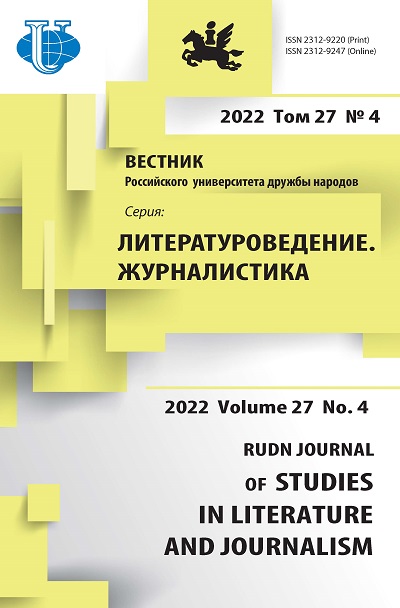Mythologisation of the fiction text in the socio-informational space
- Authors: Slobodyanyuk N.L.1
-
Affiliations:
- Boris Yeltsin Kyrgyz-Russian Slavic University
- Issue: Vol 27, No 4 (2022)
- Pages: 757-766
- Section: JOURNALISM
- URL: https://journals.rudn.ru/literary-criticism/article/view/33287
- DOI: https://doi.org/10.22363/2312-9220-2022-27-4-757-766
- ID: 33287
Cite item
Full Text
Abstract
The mechanisms of the process of mythologization of artistic text in the modern media space are considered. The role and importance of the artistic text and artistic image as an important and specific tool for modeling the socio-informational space are analyzed. The relationship between social, political, cultural processes and the nature of the aestheticization of the information and communication space is studied, the role of the artistic image and the artistic text in this process is determined. The author of the study has identified the nature of the creation, circulation and functioning of the actual myths in the modern media space, marked their impact on communication in the modern society. The phenomenon of norm mobility in modern society as a consequence of acceleration and activation of myth-making process based on the change of aesthetic characteristics of media and information and communication space in the modern world has been considered. The author also discusses the functional tasks of mythology in the context of the specifics of the media sphere and the socio-information space.
About the authors
Natalia L. Slobodyanyuk
Boris Yeltsin Kyrgyz-Russian Slavic University
Author for correspondence.
Email: evgilia@mail.ru
ORCID iD: 0000-0001-9048-3541
Candidate of Philological Sciences, Head of the Department of International Journalism
44 Kievskaya St, Bishkek, 720000, Kyrgyz RepublicReferences
- Bart, R. (1994). Effect of reality. In R. Bart, Selected Works: Semiotics. Poetics (pp. 392–400). Moscow: Progress Publ., Universal Publ. (In Russ.)
- Bennet, D. (2018). Pulsating matter: The political ecology of things. Perm: Gile Press. (In Russ.)
- Böhme, G. (1993). Atmosphere as the fundamental concept of a new aesthetics. Thesis Eleven, 36(1), 113–126. http://doi.org/10.1177/072551369303600107
- Borev, Yu.B. (2005). Aesthetics: Relation to reality. Creativity. Works. nature. Nature and types of art. Art process. Treatment of art. Moscow: Rus-Olimp Publ. (In Russ.)
- Deminova, M.A., Semilet, T.A., Fotieva, I.V., & Chutcheva, A.V. (2018). Myth-making of modern Russian journalism: Social essence, practices, determinants, tools. The World of Science, Culture and Education, 73(6), 612–614. (In Russ.)
- Dilthey, V. (2000). Introduction to the science of the spirit. Collected Works (vol. 1, pp. 15–17). Moscow: Dom Intellektualnoi Knigi Publ. (In Russ.)
- Efimova, O.V., & Delezha, E.M. (2019). Media technologies in modern art culture. Bulletin of Kazan State University of Culture and Arts, (4), 29–32. (In Russ.)
- Haraway, D. (2020). Staying with trouble: Making kindred in Hthulucene. Perm: Gile Press. (In Russ.)
- Ivanov, A.G. (2020). What is considered the mythologization of time? Myth in History, Politics, Culture: Collection of Materials of the IV International Scientific Interdisciplinary Conference (pp. 307–312). Sevastopol: MSU in Sevastopol. (In Russ.)
- Morton, T. (2018). Hyperobjects: Philosophy and ecology after the end of the world. Perm: Gile Press. (In Russ.)
- Turner, L. (2011). The metamodernist manifesto. Available from https://luketurner.com/the-metamodernist-manifesto (accessed: 20.08.2022).
- Venkova, A.V. (2018). Politics of identification in the art of metamodernism. Tomsk State University Journal of Cultural Studies and Art History, (32), 203–213. (In Russ.) http://doi.org/10.17223/22220836/32/20
- Venkova, A.V. (2021). The phenomenon of immersiveness in the aesthetics of atmospheres and the theory of the “optical unconscious”. International Journal of Cultural Research, (3), 103–113. (In Russ.) http://doi.org/10.52173/2079-1100_2021_3_103
- Venkova, A.V. (2021). Theoretical study of the phenomenon of immersiveness in object-oriented ontology and posthumanism. Tomsk State University Journal of Cultural Studies and Art History, (44), 5–13. (In Russ.) http://doi.org/10.17223/22220836/44/1
Supplementary files















